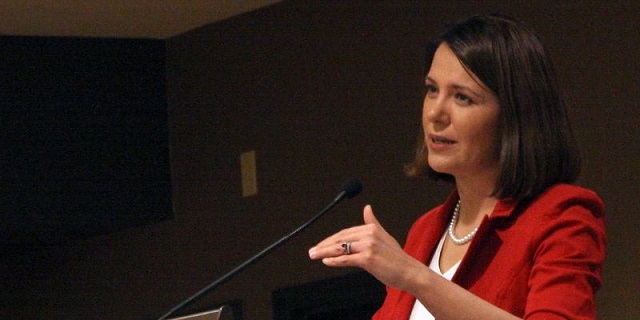Alberta
Alberta government must further restrain spending to stabilize provincial finances

From the Fraser Institute
By Tegan Hill
This year, program spending will reach a projected $14,334 per Albertan, which is $1,603 more per person (inflation-adjusted) than the Smith government originally planned to spend this year as outlined in the 2022 mid-year budget update.
Despite recording a $4.3 billion surplus last year, Premier Danielle Smith remains committed to a new approach to Alberta finances that relies less heavily on resource revenue, which includes restraining spending levels below the rate of inflation and population growth. That’s a big step forward, but is it enough to stabilize Alberta’s boom and bust rollercoaster?
First, some background.
After nearly a decade and a half of routine budget deficits, Alberta swung to a budget surplus when resource revenue (which includes includes oil and gas royalties) skyrocketed from $3.1 billion in 2020/21 to $16.2 billion in 2021/22. In 2022/23, the government enjoyed the highest level of resource revenue on record and relatively high levels have continued in recent years. Correspondingly, Alberta’s surpluses have continued.
Alberta governments have a habit of increasing spending during times of high resource revenue, such as the province is currently experiencing, to levels that are unsustainable without incurring deficits when resource revenue inevitably declines. That’s why the Smith government’s commitment to spending restraint is an important one.
Unfortunately, however, due to the Smith government’s spending increases in previous years, this restraint won’t go as far in stabilizing provincial finances. Moreover, there are a number of limitations and exceptions to these new spending rules that may impede their effectiveness.
Consider that this year, program spending will reach a projected $14,334 per Albertan, which is $1,603 more per person (inflation-adjusted) than the Smith government originally planned to spend this year as outlined in the 2022 mid-year budget update.

As shown above, program spending (inflation-adjusted) will reach a projected $14,041 per person in 2025/26 and a projected $13,750 per person in 2026/27, which is equivalent to per-person increases of $1,571 and $1,538, respectively, compared to the original plan in 2022.
So while per-person (inflation-adjusted) spending is set to decline, which aligns with the Smith government’s commitment, this restraint is starting from a higher base level due to spending decisions thus far. That means more work needs to be done to rein in spending.
Indeed, for perspective, if the Smith government had simply stuck to its original plan, spending would be closely aligned with stable, more predictable sources of revenue. And ultimately, that’s the way to avoid deficits.
There’s also several limitations and exceptions for the government’s new spending rule. For example, the spending limit applies only to “operating expense,” which does not include longer-term spending, disaster and emergency assistance, spending related to dedicated revenue, or contingencies. As a result of various limits and exceptions, total program spending growth in 2023/24 exceeds inflation and population growth by 1.8 percentage points. Put simply, these limitations and exceptions add to the risk of budget deficits.
Sustainable finances have been impeded by increases in per person spending since 2022. So while the Smith government deserves credit for its commitment to restrain spending moving forward, Alberta’s fiscal challenges aren’t over.
Author:
Alberta
Alberta Next: Immigration

From Premier Danielle Smith and Alberta.ca/Next
Let’s talk about immigration.
The Alberta we know and love was built by newcomers from all over Canada and the world; however, immigration levels must also be sustainable…and the Liberal’s open border policies have destroyed that balance resulting in high inflation and increased unemployment.
The Alberta Next Panel is asking: should Alberta take control of our own immigration system to ensure a more sustainable number newcomers that will more strongly contribute to our economy.
It’s your voice and your province. Have your say at www.alberta.ca/next
Alberta
Alberta uncorks new rules for liquor and cannabis

Alberta’s government is supporting liquor producers by enabling them to own, operate and sell their own products on large format bikes or “party bikes.”
Albertans out for a spin on a party bike or tavern tour will soon be able to sip locally made beers and spirits. Alberta’s government is updating the rules to give small liquor producers the green light to serve their own products on party bikes, removing an outdated barrier that had prevented local producers from advertising their own brands.
This is one of several red tape reduction changes to the Gaming, Liquor and Cannabis Regulation (GLCR) aimed at making life easier for small businesses and expanding responsible choices for consumers.
“We are proud that these amendments not only cut red tape in the retail segment of the liquor marketplace, but also directly open more opportunities for small manufacturers to grow their businesses.”
More freedom to grow: Liquor and cannabis reforms
In addition to the changes to party bikes, Alberta is making it easier for liquor retailers to set up shop in underused commercial space. Businesses that own or lease large buildings can now carve out a separate liquor store within their space, so long as it has its own entrance and full floor-to-ceiling walls separating it from other retail operations.
Alberta’s government is also rolling out a long-awaited change for cannabis producers: federally licensed cultivators and processors will now be able to apply for a retail licence to sell their products directly from the same property, commonly known as “farm-gate” sales. This move aligns Alberta with other provinces and gives consumers more access to homegrown cannabis products, while supporting licensed growers.
These targeted reforms are part of Alberta’s broader push to cut red tape, reduce regulatory burden, and promote a more competitive marketplace across the province.
Quick facts
- Alberta’s retail liquor industry is robust, with more than 35,000 products available across more than 1,600 retail stores
- Larger companies with other retail stores, operate multiple retail stores that have a liquor store on site, but in a separate building.
- There are 752 licenced cannabis retail stores in Alberta.
- There are 2,356 licensed cannabis products for sale in the province.
- All cannabis retailers must be licensed by AGLC.
- Licensed producers are regulated by Health Canada.
-

 Business1 day ago
Business1 day agoRFK Jr. says Hep B vaccine is linked to 1,135% higher autism rate
-

 Alberta2 days ago
Alberta2 days agoAlberta Independence Seekers Take First Step: Citizen Initiative Application Approved, Notice of Initiative Petition Issued
-

 Crime2 days ago
Crime2 days agoNational Health Care Fraud Takedown Results in 324 Defendants Charged in Connection with Over $14.6 Billion in Alleged Fraud
-

 Health2 days ago
Health2 days agoRFK Jr. Unloads Disturbing Vaccine Secrets on Tucker—And Surprises Everyone on Trump
-

 Bruce Dowbiggin2 days ago
Bruce Dowbiggin2 days agoThe Game That Let Canadians Forgive The Liberals — Again
-

 Censorship Industrial Complex2 days ago
Censorship Industrial Complex2 days agoGlobal media alliance colluded with foreign nations to crush free speech in America: House report
-

 Business19 hours ago
Business19 hours agoWhy it’s time to repeal the oil tanker ban on B.C.’s north coast
-

 Alberta17 hours ago
Alberta17 hours agoPierre Poilievre – Per Capita, Hardisty, Alberta Is the Most Important Little Town In Canada


